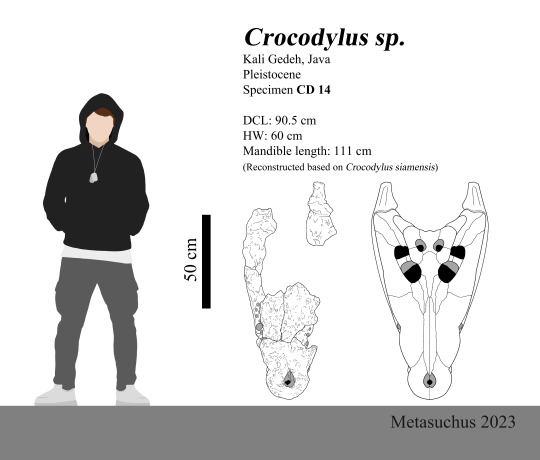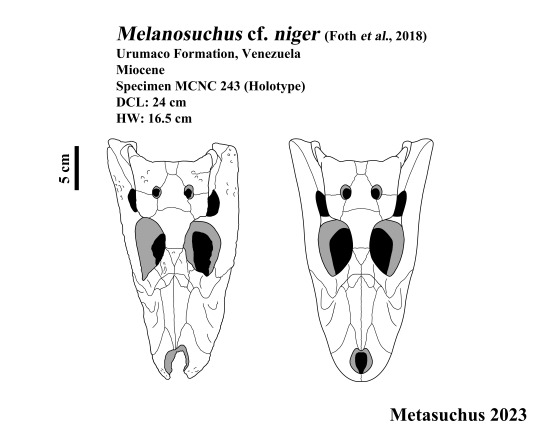A Japanese Crocodylian enthusiast that does MMA. https://linktr.ee/metasuchus
Don't wanna be here? Send us removal request.
Text
Skeletal and Osteoderm Guide of Chinese alligator

Here is the skeletal and osteoderm guide of Alligator sinensis "Chinese alligator”.
The proportions were based on Specimen No. 1335 from Cong (1998) and scaled to the largest male recorded in the wild. Osteoderm guide was made for the top view and bottom view. The details were based on skeletal diagrams from the same study and other images of Chinese alligator skeletons.
References:
Cong (1998). THE GROSS ANATOMY OF ALLIGATOR SINENSIS FAUVEL
#chinese alligator#alligator#gator#crocodilian#crocodilia#croc#crocodylomorpha#pseudosuchia#size comparison#skeletal#alligator sinensis
14 notes
·
View notes
Text
Huge Crocodylus skull from Pleistocene of Java

This is a large Crocodylus skull collected by Dubois from the late Pleistocene of Kali Gedeh. While originally described as Crocodylus ossifragus ( Synonymous with Crocodylus siamensis ), it can not be properly described due to the poor preservation of this specimen.
My reconstruction is based on C. siamensis and it resulted in a lower jaw length of 111 cm which is close to the ca. 105 cm estimate given by Delfino and de Vos (2014). There are several other large skulls from Java described as C. ossifragus that are much larger than the modern C. siamensis skulls.
References:
Delfino and de Vos (2014). A giant crocodile in the Dubois Collection from the Pleistocene of Kali Gedeh (Java)
#siamese crocodile#crocodylus siamensis#crocodylus#crocodile#crocodilia#croc#crocodilian#crocodylomorpha#pseudosuchia#fossil#paleoart#paleontology#size comparison#java#pleistocene
25 notes
·
View notes
Text
The Miocene Black caiman, Melanosuchus cf. niger

Here is a restoration of the skull of Melanosuchus cf. niger from the Miocene of South America. The holotype MCNC 243 along with a few specimens were described as Melanosuchusfisheri. MCZ 4336, the specimen on which diagnostic features of Melanosuchusfisheri were based on was reassigned to Globidentosuchusbrachyrostris.
It is possible that the holotype represents a sister species to the extant Black caiman ( Melanosuchus niger ) because of its Miocene origins but since no diagnostic features can be established due to its poor preservation, it was retained as Melanosuchus cf. niger.
References:
Bona et al., (2017). Shedding Light on the Taxonomic Diversity of the South American Miocene Caimans: The Status of Melanosuchus fisheri (Crocodylia, Alligatoroidea)
Foth et al., (2018). Cranial shape variation in jacarean caimanines (Crocodylia, Alligatoroidea) and its implications in the taxonomic status of extinct species: The case of Melanosuchus fisheri
#black caiman#melanosuchus niger#melanosuchus#caiman#croc#crocodilian#crocodilia#crocodylomorpha#pseudosuchia#fossil#paleontology#skeletal#miocene#venezuela#size comparison#paleoart
19 notes
·
View notes
Text
Astorgosuchus, the Giant from the Bugti Hills

Astorgosuchus bugtiensis ( formerly Crocodilus bugtiensis ) was a large basal Crocodyloid from the Oligocene of Bugti Hills in Pakistan. There are only 3 specimens described, which includes a fragmentary rostrum and 2 fragmentary dentaries. The specimen reconstructed here is NHMUK R.5266, a missive fragmentary dentary.
The reconstruction of the mandible is based on Asiatosuchus germanicus, a basal Crocodyloid. This results in a mandible length of 156 cm which makes it a contender for the largest Crocodyloids and the largest Crocodylians ever. They were apex predators of the region and preyed on a variety of animals including Paraceratherium, Rhinoceros and Chalicotheres.
References: Martin et al., (2019). A large crocodyloid from the Oligocene of the Bugti Hills, Pakistan
#astorgosuchus bugtiensis#astorgosuchus#crocodile#croc#crocodilian#crocodilia#crocodylomorpha#pseudosuchia#fossil#paleontology#skeletal#oligocene#pakistan#size comparison#paleoart
74 notes
·
View notes